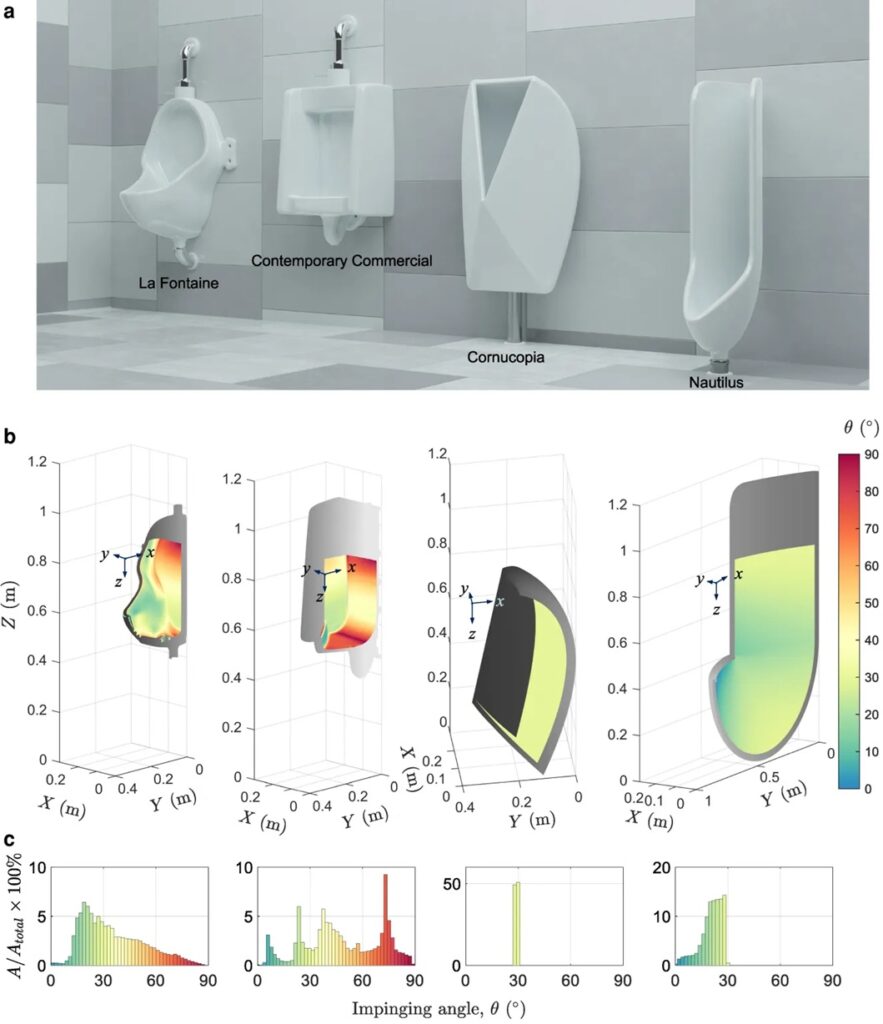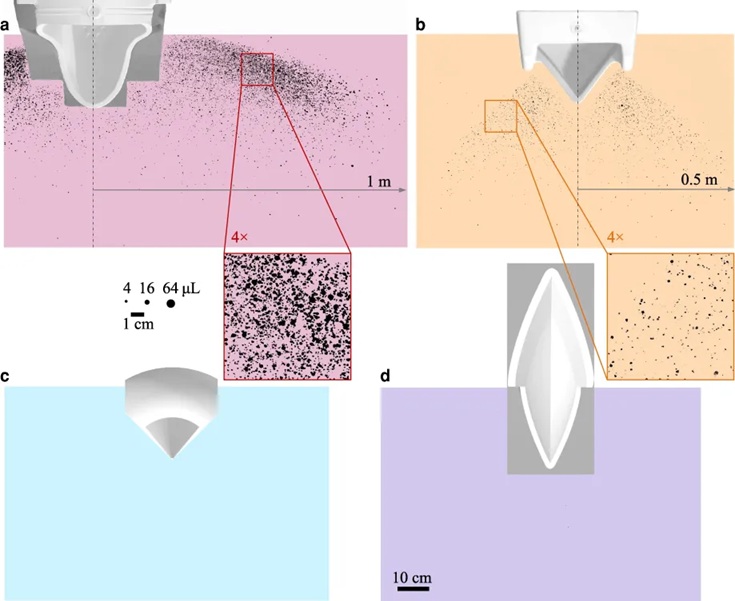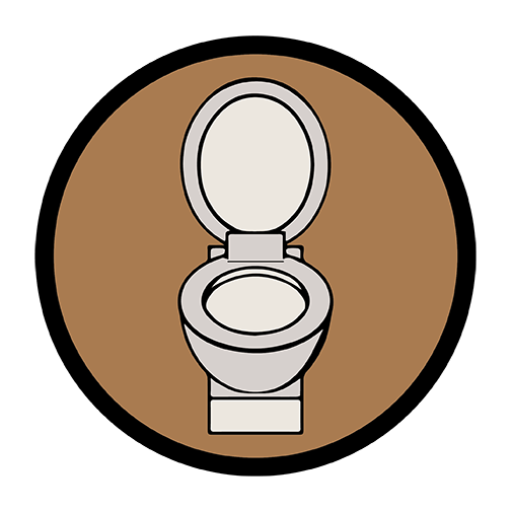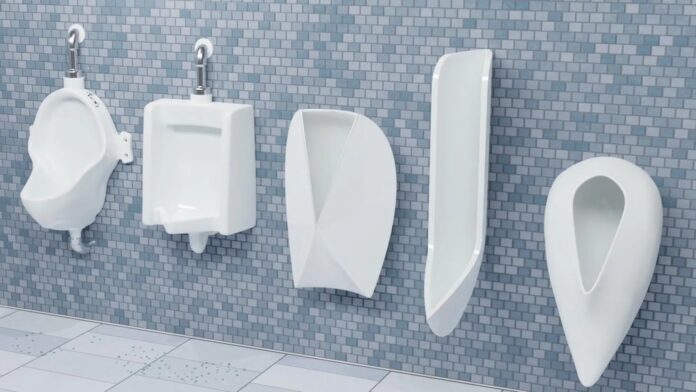Revolutionary urinal designs slash splashback by 98.6%, promising cleaner public restrooms and massive water savings
From ancient Sri Lankan monasteries to modern public restrooms, urinals have remained surprisingly unchanged for centuries despite their well-known drawbacks. Innovative research is finally addressing one of their most persistent problems: splashback.
A brief History of the urinal
As reported here, urinals trace back to approximately 1000 CE, when Sri Lankan monasteries installed intricately carved stone receptacles. European versions gained popularity in the 19th century through the work of Parisian civil servant Claude-Philibert Barthelot. By 1917, urinals had become so culturally significant that Marcel Duchamp famously transformed one into his controversial art piece “La Fontaine.” Today’s standard urinal designs remain almost identical to Duchamp’s century-old readymade.
The splashback problem: more than just inconvenience
While most individuals only occasionally experience the unpleasant splash, the cumulative impact is substantial. A 2019 study estimated that America’s approximately 56 million urinals splatter public bathroom floors with up to 1 million liters of urine daily.

Although urine is mostly sterile when excreted, it quickly becomes a bacterial breeding ground. Its ammonia-laden odor permeates the surrounding air, creating hygiene issues beyond mere discomfort. The result: urinals and bathroom floors harbor significantly higher bacteria concentrations compared to toilets, necessitating additional cleaning efforts. These cleaning demands translate directly to increased labor costs and resource consumption for public institutions.
Science-driven innovation: the Cornucopia and Nautilus
108 years after Duchamp’s “La Fontaine,” urinals may finally receive scientifically optimized upgrades. An international team led by researchers at Canada’s University of Waterloo has developed two groundbreaking designs: the “Cornucopia” and the “Nautilus.” Published in the April 2023 issue of PNAS Nexus, these innovations leverage principles of fluid dynamics to dramatically reduce splashback.

“This urinal design project is the best teaching tool I can think of,” explains Zhao Pan, University of Waterloo mechanical and mechatronics engineering professor and lead author of the study. “It’s a daily-life problem that covers numerous topics—including fluid mechanics, sustainability, differential equations, manufacturing and prototyping, art, industrial design, human factors, biomechanics, and testing.”
Learning from nature: dogs and nautilus shells
Surprisingly, part of the project’s inspiration came from canine behavior. Dogs unconsciously urinate against trees at specific angles that minimize splashing—a natural solution to an age-old problem.
The researchers tackled what’s known as an “isogonal curve problem,” analyzing how urine’s angled interactions with surfaces produce spiral patterns similar to nautilus shell geometry. Through rigorous testing using dyed water jets approximating human urine flow, they compared five different urinals: a standard North American design, a model of Duchamp’s “La Fontaine,” and three of their own prototypes.
The critical angle discovery
The breakthrough came from a simple but powerful finding: “When a liquid jet or droplet train impacts a rigid surface below a certain critical impinging angle, almost no splatter is generated,” the researchers noted. “Thus, a surface designed to always intersect the urine stream at an angle equal to or smaller than the critical angle prevents splashback.”
Specifically, splashback reduces dramatically when liquid strikes a surface at angles of 30 degrees or less. The team’s new designs successfully reduced splashes to just 1.4% of what standard North American models produce. While the Cornucopia is designed for standing users, the Nautilus accommodates people with disabilities and wheelchair users, making it a more inclusive solution.
Environmental and economic impact
The researchers believe widespread adoption of these designs would yield substantial benefits: “The widespread adoption of the urinal designs described in this work would result in considerable conservation of human resources, cost, cleaning chemicals, and water usage,” they wrote.
Conservative estimates suggest that replacing all U.S. public urinals with Nautilus-style designs would reduce splashback by 1 million liters daily. “Assuming 10 times as much water is required to clean a particular volume of splashed urine, we can save up to 10 million liters of fresh water used for cleaning per day,” they calculated.
From everyday observation to scientific innovation
Despite its sophisticated scientific foundations, the project began with a simple observation. “The idea for this project truly originated—well, exactly where you think it did,” Pan admitted. “When you study fluid behavior all day, you can’t help but wonder about these everyday scenarios.”
Through this research, a mundane bathroom fixture may finally receive its first major redesign in over a century, proving that scientific innovation can transform even the most overlooked aspects of our daily environments.

